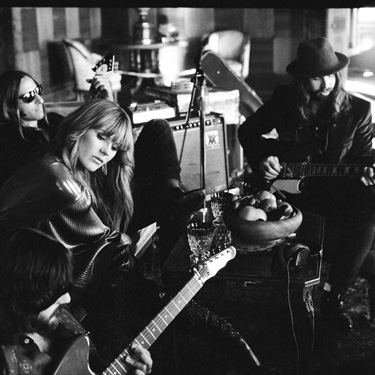|
 © Lauren Dukoff © Lauren Dukoff
HOPEWELL JUNCTION, NEW YORK: Grace Potter and the Nocturnals’ self-titled album – their third studio release – debuted at #19 on the US Billboard Top 200 upon its release and set the band off on a string of sold-out shows and television appearances that show no sign of slowing, including recent performances on The Late Show with David Letterman, Conan and Emmy-nominated music show Live from The Artists Den. The band’s brand of rock gives listeners plenty to hook into, and the live show amplifies that effect by the fiery charisma of lead singer Potter at her vintage Hammond B3 and her band of talented players. The group is currently packing theaters across the U.S., and it is easy to extrapolate that the next go-around will require much larger venues. Front-of-house engineer Sam Leonard, who frequently also handles every other aspect of the band’s technical underbelly with the help of only one tech, has recently begun to record every Grace Potter and the Nocturnals show using either eight channels or twenty-four channels of Metric Halo’s acclaimed 2882 mic preamp/converter.
“Their former live engineer had a Metric Halo 2882 that was bestowed to me when I took the job,” said Leonard. “The 2882 is the most affordable way to get Metric Halo’s preamps and conversion, but I toyed with the idea of going with another less expensive manufacturer that I already owned. An A/B test quickly illuminated the folly of such thinking. The difference was night and day. The Metric Halo 2882 had an overall fidelity that I had been killing myself to try to ‘process in’ with the other converter. The stereo imaging was robust and the harmonic overtones were rich and detailed. It’s now clear to me that the 2882 far outperforms anything else in its price range.”
Where space and time permit, Leonard uses three Metric Halo 2882s to capture twenty-four tracks of Grace and the band using the Metric Halo MIO Console software running on a “modest” MacBook Pro. He uses an isolated split at the FOH console to divert the stage inputs to the small-footprint 2882s. “The MIO Console is rock solid,” said Leonard. “I’ve recorded fifteen shows or so with full twenty four-track inputs and it has performed flawlessly.”
When space or time are not so bountiful (or when the 2882s must be located within drink-spilling range of the crowd), Leonard records eight tracks with just one 2882. A stereo pair at the FOH position captures the mix as Leonard hears it, while a stereo mic on stage captures the band’s very energetic (literally) stage volume. A stereo feed from the board consumes the fifth and sixth tracks. The mixed bass DI and mic fill the seventh track, while a blend of lead, rhythm, and acoustic guitars claims the eighth. “For mixdown, I have to time-align the waves to match up,” said Leonard. “You might not guess it, but that can sometimes be tricky. When it’s done properly however, the results are really cool. For me, that’s the best way to capture the sound of the performance without committing each individual channel to disc.”
What will become of these recordings? That depends on a few things. First, although the popularity of Grace Potter and the Nocturnals is growing exponentially and the size of the venues they play is growing linearly, the size of the band’s road crew is not growing at all. “There is some hope that we will be able to add a dedicated recording engineer to the crew,” explained Leonard. “We could then venture to produce a mixdown that would be ready for fans at the end of the show.” Outside of that, of course, the recordings may find their way to a live album. |